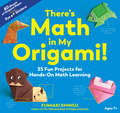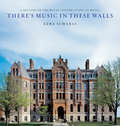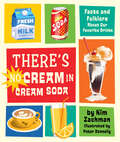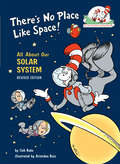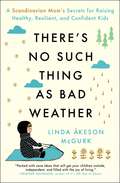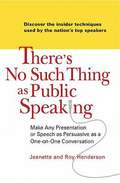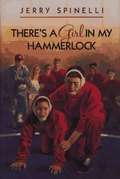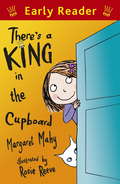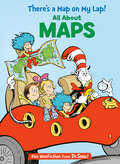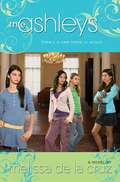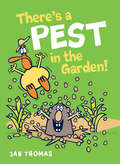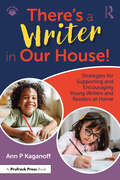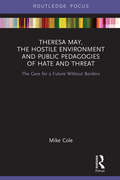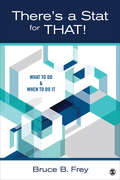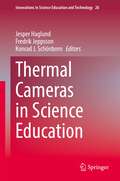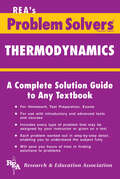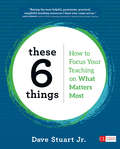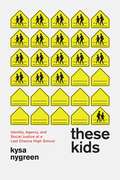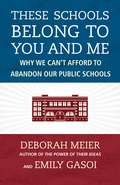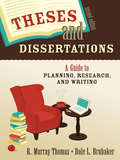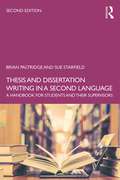- Table View
- List View
There's Math in My Origami!: 35 Fun Projects For Hands-on Math Learning
by Fumiaki Shingu35 creative origami designs plus brain-teasing math questions add up to the perfect math activity for kids Discover how fractions, shapes, and symmetry turn a flat sheet of paper into a 3D work of art! Each one of the 35 amazing projects in There’s Math in My Origami!invites kids to: Follow the simple, step-by-step instructions Flex their math skills by answering a fun quiz question Fold adorable origami like they’ve never seen before! Includes educational projects for kids ages 7 and up—plus 2 pages of eye stickers, and 80 sheets of origami paper!
There's Music In These Walls: A History of the Royal Conservatory of Music
by Ezra SchabasThe Royal Conservatory of Music, founded in 1886, is rich in history and genius. Its long tradition of excellence in musical training and examining places it among the leading music schools of the world. Glenn Gould, Lois Marshall, Teresa Stratas, Jon Vickers, Mario Bernardi, and many other international artists have studied there. Amply illustrated, with over forty photographs dating back to the school’s first years, this book is an unvarnished account of its controversial leaders, its successes and failures, its encounters with the musical and academic world, and its passions. In this smoothly paced narrative, your favourite musicians, teachers, and examiners will come to life to revive your memories.
There's No Cream in Cream Soda: Facts and Folklore About Our Favorite Drinks
by Kim ZachmanFrom soda to water to milk and juice, this refreshing follow-up to There's No Ham in Hamburgers is full of fun facts and origin stories of some of America&’s most popular drinks. People have been inventing drinks for thousands of years. Kinda weird when you consider that humans only need two liquids to survive—water and milk—and we don&’t need milk once we can eat solid foods. So, why did humans, unlike other mammals, begin concocting new beverages? It likely started with safety—boiling water to make it safer to drink, and then adding in berries or leaves or roots to make it taste better. Sometimes, it was thought that enhancing drinks made them healthier (i.e. bubbly water restored vitality). Did you know that some of the most popular sodas were created by pharmacists? Americans spend approximately $150 billion on soft drinks, coffee, and tea each year. Why? This book offers some possible answers!
There's No Place Like Space! All About Our Solar System: All About Our Solar System (The Cat in the Hat's Learning Library)
by Tish RabeLaugh and learn with fun facts about the sun, the moon, the planets, constellations, astronauts, and more—all told in Dr. Seuss&’s beloved rhyming style and starring The Cat in the Hat! &“The universe is a mysterious place. We are only just learning what happens in space.&” The Cat in the Hat&’s Learning Library series combines beloved characters, engaging rhymes, and Seussian illustrations to introduce children to non-fiction topics from the real world! On this adventure into outer space, readers will discover: • what makes each planet in our solar system unique• how a million Earths could fit inside the sun• how astronauts have driven a special car all over the moon• and much more! Perfect for story time and for the youngest readers, There&’s No Place Like Space: All About Our Solar System also includes an index, glossary, and suggestions for further learning. Look for more books in the Cat in the Hat&’s Learning Library series!Cows Can Moo! Can You? All About FarmsHark! A Shark! All About SharksIf I Ran the Dog Show: All About DogsOh Say Can You Say Di-no-saur? All About DinosaursOn Beyond Bugs! All About InsectsOne Vote Two Votes I Vote You VoteWho Hatches the Egg? All About EggsWhy Oh Why Are Deserts Dry? All About DesertsWish for a Fish: All About Sea Creatures
There's No Such Thing as Bad Weather: A Scandinavian Mom's Secrets for Raising Healthy, Resilient, and Confident Kids (from Friluftsliv to Hygge)
by Linda Åkeson Mcgurk“A perfect antidote to the hyper-vigilant, extra-electrified, standardized-tested, house-arrested, 21st-century childhood.” —Richard Louv, bestselling author of Last Child in the Woods and Vitamin N Bringing Up Bébé meets Last Child in the Woods in this lively, insightful memoir about a mother who sets out to discover if the nature-centric parenting philosophy of her native Scandinavia holds the key to healthier, happier lives for her American children.When Swedish-born Linda McGurk moved to small-town Indiana with her American husband to start a family, she quickly realized that her outdoorsy ways were not the norm. In Sweden children play outside all year round, regardless of the weather, and letting young babies nap outside in freezing temperatures is not only common—it is a practice recommended by physicians. In the US, on the other hand, she found that the playgrounds, which she had expected to find teeming with children, were mostly deserted. In preschool, children were getting drilled to learn academic skills, while their Scandinavian counterparts were climbing trees, catching frogs, and learning how to compost. Worse, she realized that giving her daughters the same freedom to play outside that she had enjoyed as a child in Sweden could quickly lead to a visit by Child Protective Services. The brewing culture clash finally came to a head when McGurk was fined for letting her children play in a local creek, setting off an online firestorm when she expressed her anger and confusion on her blog. The rules and parenting philosophies of her native country and her adopted homeland were worlds apart. Struggling to fit in and to decide what was best for her children, McGurk turned to her own childhood for answers. Could the Scandinavian philosophy of “there is no such thing as bad weather, only bad clothes” be the key to better lives for her American children? And how would her children’s relationships with nature change by introducing them to Scandinavian concepts like friluftsliv (“open-air living”) and hygge (the coziness and the simple pleasures of home)? McGurk embarked on a six-month-long journey to Sweden to find out. There’s No Such Thing as Bad Weather is a fascinating personal narrative that highlights the importance of spending time outdoors, and illustrates how the Scandinavian culture could hold the key to raising healthier, resilient, and confident children in America.
There's No Such Thing as Public Speaking
by Jeanette And HendersonTwo top public-speaking coaches offer fresh advice on giving effective speeches and presentations with the immediacy of a conversation. The best speeches don't sound like speeches, and the best speakers make listeners feel as though they are being addressed directly. The trick is to make every presentation as natural and direct as a one-on-one conversation. This expert but accessible guide reveals: - The six truths behind every conversation-and how to use them at the podium - The three steps to inspiring any audience - The seven secrets for using voice and body language - The seven tools every speaker uses or misuses Whether addressing a few colleagues or a packed auditorium, readers will find practical and simple techniques for inspiring every listener. .
There's a Girl in My Hammerlock
by Jerry SpinelliWhen Maisie learns Eric is going out for the junior high wrestling team, she decides to try out for it too. What can get her closer to a boy than wrestling? It isn't long before Maisie finds out that she loves wrestling and has even earned Coach Cappelli's grudging support. Unfortunately, Maisie also comes to see that the coach was right when he said, "Wrestling is a men and boys' world." Most of the boys are far from happy to see her in the wrestling room, and it becomes harder and harder to buck the current of hostile boys, school opinion, and the nasty letters that turn up in the local newspaper. As for Eric, Maisie may get close to him in the wrestling room, but it's Lizard Liz Lampley he takes to the dances. The sign in the coach's office says, "It takes a little more to be a champion." Does Maisie have what it takes to stick it out--and win? With his usual flair and ability to target the concerns of young reader, Newberry Medal-winning writer Jerry Spinelli tackles some prevailing preconceptions about sex roles and pin them firmly to the mat. Readers will cheer Maisie and her champion spirit right to the end.
There's a King in the Cupboard (Early Reader)
by Margaret MahyEarly Readers are stepping stones from picture books to reading books. A blue Early Reader is perfect for sharing and reading together. A red Early Reader is the next step on your reading journey.A family move into a new house. They are just a small family - a mum, a dad and a little girl called Sarah. It is a big old house full of space and echoes. And Sarah is sure there is something very magical indeed about the cupboard under the stairs...A brand-new full colour Early Reader edition of this charming story from the CARNEGIE-winning and HANS CHRISTIAN ANDERSEN AWARD-nominee author Margaret Mahy, with illustrations by Rosie Reeve.
There's a Map on My Lap! All About Maps: All About Maps (The Cat in the Hat's Learning Library)
by Tish RabeLaugh and learn with fun facts about mapmakers, geography, compasses, and more—all told in Dr. Seuss&’s beloved rhyming style and starring the Cat in the Hat! &“You may travel the world, but no matter how far, with a map on your lap you will know where you are.&” The Cat in the Hat&’s Learning Library series combines beloved characters, engaging rhymes, and Seussian illustrations to introduce children to non-fiction topics from the real world! Go on a journey and learn: • how to read the latitude and longitude lines on a map• why a hiker uses a topographical map• why mapmakers use a scale and legends• and much more! Perfect for story time and for the youngest readers, There&’s a Map on My Lap! All About Maps also includes an index, glossary, and suggestions for further learning. Look for more books in the Cat in the Hat&’s Learning Library series!If I Ran the Horse Show: All About HorsesClam-I-Am! All About the BeachMiles and Miles of Reptiles: All About ReptilesA Whale of a Tale! All About Porpoises, Dolphins, and WhalesSafari, So Good! All About African WildlifeOh, the Lavas That Flow! All About VolcanoesOut of Sight Till Tonight! All About Nocturnal AnimalsWhat Cat Is That? All About CatsOnce upon a Mastodon: All About Prehistoric MammalsOh Say Can You Say What's the Weather Today? All About WeatherThe Cat on the Mat: All About Mindfulness
There's a New Name in School (The Ashleys #1)
by Melissa de la CruzThe Ashleys rule Miss Gamble's Preparatory School for Girls. They are gorgeous, rich, impeccably fashion forward, and, yes, all named Ashley. Lauren Page has gone to the same school with them her whole life, and the Ashleys, if forced to remember, might recall only a faint memory of shoving mud in the poor girl's mouth in kindergarten. But Lauren Page is no longer the mud-eating loser she once was. And though she has completely changed her exterior from bargain-basement cast-offs to off-the-runway couture (props, of course, to her new personal shopper) she is still the same person on the inside. And that person has had enough of the current regime. Look out, Ashleys. There's a new name in school.
There's a Pest in the Garden! (The Giggle Gang)
by Jan ThomasSomeone&’s eating all the veggies in this colorful picture book with &“a satisfying, funny conclusion&” (Kirkus Reviews).There&’s a pest in the garden and he&’s eating all the vegetables! But Duck has a plan to save the day (well, sort of)… Featuring Jan Thomas&’s wonderfully wacky humor, rowdy repetitions, and hilarious characters, this book is sure to have young readers laughing out loud!
There's a Writer in Our House! Strategies for Supporting and Encouraging Young Writers and Readers at Home
by Ann P. KaganoffThere’s a Writer in Our House! is an invitation to parents of children in first grade through fifth grade interested in actively participating in their children’s early literacy learning from the very first steps.Founded upon well-researched literacy instructional methods that have been informed by the author’s clinical perspective as well as her years of experience with many kinds of learners, this book provides a valuable understanding of how both writing and reading contribute to child development in multiple areas. Chapters provide background concepts regarding grammar and specific critical thinking skills in both writing and reading as well as customizable, child-centered activities used to practice and build writing and reading comprehension skills.You will learn how to advance and encourage your child’s learning and communication skills by highlighting important literacy areas such as vocabulary development, background knowledge, and critical thinking. You will also learn to recognize and track the significant developmental achievements of your child as you proceed from the early to the more complex At-Home activities, as well as receive strategies for how to respond and give feedback in specific situations, such as when a child writes something that makes sense to the child but not to the parent, how to offer feedback that identifies and labels a child’s strengths, and how to collaborate effectively with a child who is just developing new interests or a new willingness to try something that previously seemed “hard.”Practical, accessible, and most importantly, fun, this book is a must-read for all parents, regardless of background, seeking to support their children’s ongoing literacy development confidently and effectively.
Theresa May, The Hostile Environment and Public Pedagogies of Hate and Threat: The Case for a Future Without Borders (Routledge Research in Education Policy and Politics)
by Mike ColeTheresa May, The Hostile Environment and Public Pedagogies of Hate and Threat analyses Theresa May’s involvement in the creation and promotion of public pedagogies of hate and threat around the issue of immigration, which are used to instil fear, stress and anxiety among large sections of the population. This book uses public pedagogy as a theoretical lens and examines the economic and political backdrop to the hostile environment, before moving on to a consideration of its creation and consolidation by Theresa May as Home Secretary and later as Prime Minister. The effects of the hostile environment on health and education are addressed, as well as its specific impacts on asylum seekers and women. The book also interrogates the Windrush scandal and divided families, as well as the author and his family's personal experiences of the hostile environment. It concludes by considering the escalation of racism in general, the crisis in neoliberalism, and the case for a socialist future without borders. This topical book will appeal to doctoral, postgraduate and advanced undergraduate students in the fields of education studies, pedagogy and sociology as well as those interested in UK politics.
There′s a Stat for That!: What to Do & When to Do it
by Bruce B. FreyBruce Frey’s There’s a Stat for That! is a brief, straightforward, and to-the-point guide to deciding which statistical analysis to use and when to use it. Designed for consultants, researchers, students, and those who already have the resources to tell them how to perform the analyses, this text explains why a particular statistical approach is the right one to use. The book affirms that regardless of the group design, once the variables are chosen and the measurement strategy is worked out, one can rest assured that there is a stat for that!
There′s a Stat for That!: What to Do & When to Do it
by Bruce B. FreyBruce Frey’s There’s a Stat for That! is a brief, straightforward, and to-the-point guide to deciding which statistical analysis to use and when to use it. Designed for consultants, researchers, students, and those who already have the resources to tell them how to perform the analyses, this text explains why a particular statistical approach is the right one to use. The book affirms that regardless of the group design, once the variables are chosen and the measurement strategy is worked out, one can rest assured that there is a stat for that!
Thermal Cameras in Science Education (Innovations in Science Education and Technology #26)
by Jesper Haglund Fredrik Jeppsson Konrad J. SchönbornThis book presents a collection of educational research and developmental efforts on the rapidly emerging use of infrared cameras and thermal imaging in science education. It provides an overview of infrared cameras in science education to date, and of the physics and technology of infrared imaging and thermography. It discusses different areas of application of infrared cameras in physics, chemistry and biology education, as well as empirical research on students’ interaction with the technology. It ends with conclusions drawn from the contributions as a whole and a formulation of forward-looking comments.
Thermodynamics Problem Solver
by The Editors of REA Ralph PikeREA's Thermodynamics Problem Solver Each Problem Solver is an insightful and essential study and solution guide chock-full of clear, concise problem-solving gems. Answers to all of your questions can be found in one convenient source from one of the most trusted names in reference solution guides. More useful, more practical, and more informative, these study aids are the best review books and textbook companions available. They're perfect for undergraduate and graduate studies. This highly useful reference provides thorough coverage of pressure, work and heat, energy, entropy, first and second laws, ideal gas processes, vapor refrigeration cycles, mixtures, and solutions. For students in engineering, physics, and chemistry.
These 6 Things: How to Focus Your Teaching on What Matters Most (Corwin Literacy)
by Dave StuartStreamline literacy instruction while increasing student achievement Dave R. Stuart Jr.’s work is centered on a simple belief: all students and teachers can flourish. Yet that seemingly simple goal can feel unattainable when teachers are expected to teach core content within the disciplines and improve literacy in their classrooms. How can teachers and students flourish under so much pressure? Stuart’s advice: Take a deep breath and refocus on six known best practices— establish and strengthen key beliefs, then build knowledge and increase reading, writing, speaking and listening, and argumentation in every content area, every day. These 6 Things is all about streamlining your practice so that you’re teaching smarter, not harder, and kids are learning, doing, and flourishing in ELA and content-area classrooms. In this essential new resource, teachers will receive Proven, classroom-tested advice delivered in an approachable, teacher-to-teacher style that builds confidence Practical strategies for streamlining instruction in order to focus on key beliefs and literacy-building activities Solutions and suggestions for the most common teacher and student "hang-ups" Numerous recommendations for deeper reading on key topics In addition to teaching English and world history for more than a decade, Stuart is well-known for his blog DaveStuartJr.com, which has over 35,000 visitors each month. This popular resource has been a beacon of light for more than 10,000 subscribers who refuse to freak out about the everyday challenges of teaching in a high-stakes era. He presents professional development workshops and institutes for schools around the United States and offers a number of online learning tools and experiences on his website.
These 6 Things: How to Focus Your Teaching on What Matters Most (Corwin Literacy)
by Dave StuartStreamline literacy instruction while increasing student achievement Dave R. Stuart Jr.’s work is centered on a simple belief: all students and teachers can flourish. Yet that seemingly simple goal can feel unattainable when teachers are expected to teach core content within the disciplines and improve literacy in their classrooms. How can teachers and students flourish under so much pressure? Stuart’s advice: Take a deep breath and refocus on six known best practices— establish and strengthen key beliefs, then build knowledge and increase reading, writing, speaking and listening, and argumentation in every content area, every day. These 6 Things is all about streamlining your practice so that you’re teaching smarter, not harder, and kids are learning, doing, and flourishing in ELA and content-area classrooms. In this essential new resource, teachers will receive Proven, classroom-tested advice delivered in an approachable, teacher-to-teacher style that builds confidence Practical strategies for streamlining instruction in order to focus on key beliefs and literacy-building activities Solutions and suggestions for the most common teacher and student "hang-ups" Numerous recommendations for deeper reading on key topics In addition to teaching English and world history for more than a decade, Stuart is well-known for his blog DaveStuartJr.com, which has over 35,000 visitors each month. This popular resource has been a beacon of light for more than 10,000 subscribers who refuse to freak out about the everyday challenges of teaching in a high-stakes era. He presents professional development workshops and institutes for schools around the United States and offers a number of online learning tools and experiences on his website.
These Kids: Identity, Agency, and Social Justice at a Last Chance High School
by Kysa NygreenFew would deny that getting ahead is a legitimate goal of learning, but the phrase implies a cruel hierarchy: a student does not simply get ahead, but gets ahead of others. In "These Kids," Kysa Nygreen turns a critical eye on this paradox. Offering the voices and viewpoints of students at a last chance high school in California, she tells the story of students who have, in fact, been left behind. Detailing a youth-led participatory action research project that she coordinated, Nygreen uncovers deep barriers to educational success that are embedded within educational discourse itself. Struggling students internalize descriptions of themselves as at risk, low achieving, or troubled and by adopting the very language of educators, they also adopt its constraints and presumption of failure. Showing how current educational discourse does not, ultimately, provide an adequate vision of change for students at the bottom of the educational hierarchy, she levies a powerful argument that social justice in education is impossible today precisely because of how we talk about it. "
These Kids: Identity, Agency, and Social Justice at a Last Chance High School
by Kysa NygreenFew would deny that getting ahead is a legitimate goal of learning, but the phrase implies a cruel hierarchy: a student does not simply get ahead, but gets ahead of others. In These Kids, Kysa Nygreen turns a critical eye on this paradox. Offering the voices and viewpoints of students at a “last chance” high school in California, she tells the story of students who have, in fact, been left behind. Detailing a youth-led participatory action research project that she coordinated, Nygreen uncovers deep barriers to educational success that are embedded within educational discourse itself. Struggling students internalize descriptions of themselves as “at risk,” “low achieving,” or “troubled”—and by adopting the very language of educators, they also adopt its constraints and presumption of failure. Showing how current educational discourse does not, ultimately, provide an adequate vision of change for students at the bottom of the educational hierarchy, she levies a powerful argument that social justice in education is impossible today precisely because of how we talk about it.
These Rocks Count!
by Sarah Snow Alison FormentoMr. Tate's class is about to learn that there's more to rocks than being dirty lumps on the ground. On this field trip they're visiting the rocky ridge mountains to learn about rocks. At first the children think rocks will be boring, but they soon learn that rocks are all around us in ways we might not expect--such as glass and toothpaste! This is a fixed-format ebook, which preserves the design and layout of the original print book.
These Schools Belong to You and Me: Why We Can't Afford to Abandon Our Public Schools
by Deborah Meier Emily GasoiA challenge to narrow, profit-driven conceptions of school success and an argument for protecting public education to ensure that all students become competent citizens in a vibrant democracyIn These Schools Belong to You and Me, MacArthur award–winning educator, reformer, and author Deborah Meier draws on her fifty-plus years of experience to argue that the purpose of universal education is to provide young people with an “apprenticeship for citizenship in a democracy.” Through an intergenerational exchange with her former colleague and fellow educator Emily Gasoi, the coauthors analyze the last several decades of education reform, challenging narrow profit-driven conceptions of school success. Reflecting on the trajectory of education and social policies that are leading our country further from rule “of, for, and by the people,” the authors apply their extensive knowledge and years of research to address the question of how public education must change in order to counter the erosion of democratic spirit and practice in schools and in the nation as a whole. Meier and Gasoi candidly reflect on the successes, missteps, and challenges they experienced working in democratically governed schools, demonstrating that it is possible to provide an enriched education to all students, not just the privileged few. Arguing that public education and democracy are inextricably bound, and pushing against the tide of privatization, These Schools Belong to You and Me is a rousing call to both save and improve public schools to ensure that all students are empowered to help shape our future democracy.
Theses and Dissertations: A Guide to Planning, Research, and Writing
by Dr R. Murray Thomas Dale L. BrubakerOffers updated references, a new section on the Internet, and information on plagiarism. Covers the entire writing process: preparation, selecting topics, collecting information, interpreting results, and final presentation.
Thesis and Dissertation Writing in a Second Language: A Handbook for Students and their Supervisors
by Brian Paltridge Sue StarfieldFully updated and packed with new material, the second edition of Thesis and Dissertation Writing in a Second Language is the ideal guide for non-native speaker students and their supervisors working on writing a thesis or dissertation in English. Considering the purposes of thesis and dissertation of writing alongside writer/reader relationships, this book uses accessible language and practical examples to discuss issues that are crucial to successful thesis and dissertation writing. This edition offers: Insights into the experience of being a doctoral writer, issues of writer identity and writing with authority Typical language and discourse features of theses and dissertations Advice on the structure and organisation of key sections Suggestions for online resources which support writing Extracts from completed theses and dissertations Guidance on understanding examiner expectations Advice on publishing from a PhD Suitable for students from all disciplines, Thesis and Dissertation Writing in a Second Language is essential reading for non-native speaker students looking to complete a thesis or dissertation in English.
